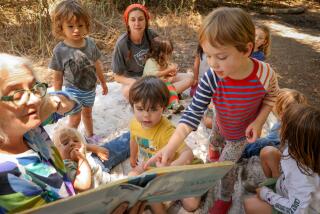For Schoolchildren, Field Trips Are a Preview of Life’s Yellow Brick Road
- Share via
In a way, my travels started in the fourth grade in St. Louis when I went on a school field trip to nearby Springfield, Ill., the home and burial place of Abraham Lincoln. I don’t remember the modest house where three of Lincoln’s sons were born or the Old State Capitol. But I can still see the gleaming yellow school bus that took me and my classmates on the adventure, as potent to me then as Dorothy’s ruby slippers.
This school trip and others seeded my desire to see the world. “Children get a sense of independence and discover that they are citizens of the world,” says Margaret Bowles, associate head of academic affairs at Viewpoint, a private K-12 school in Calabasas, who has taken school groups as far afield as China.
Moreover, school trips teach children how to handle themselves away from their parents, how to eat in a restaurant and behave during a lecture. “A lot is learned in terms of life skills,” says Vincent Ferrandino, executive director of the National Assn. of Elementary School Principals in Alexandria, Va.
Of course, the real purpose of a school trip is to teach children about a specific subject--colonial America in Williamsburg, Va.; ecology in the Channel Islands; the animal world at the San Diego Zoo. Educators say such trips are an important part of school curricula at all levels. My mother, who taught middle school social studies for 20 years, says trips give children a chance to see and hear what their teacher has been telling them about, bringing to life subjects as varied as geology and government.
Mary Jane Collier, principal of Ivanhoe Elementary in Los Angeles, who accompanied 60 fifth-graders last year on a four-day trip to Washington, D.C., says that children become especially alert to learning when they’re out of the classroom and confronted with new faces and places.
At Viewpoint school, children from fourth to 12th grade go on a big trip every year. These include at least one night away from home--three-day Astrocamp at the Desert Sun Science Center in Idyllwild for fifth-graders, four days on Catalina Island for sixth-graders and the eighth-grade plum, a six-day geology and ecology program at Yosemite.
Westland, a private elementary school in L.A., starts 6- and 7-year-olds with short trips to farms, dairies, restaurants and stores to see how food comes to the table. It requires parents to serve as chauffeurs on two trips a year.
Moms and dads can enrich their children’s education during family vacations, but school trips are usually specifically designed with learning in mind. “The purpose of the trip has to be embedded in the curriculum. It’s not just see as we go,” says Sylvia Seidel, a director at the National Education Assn. in Washington, D.C. This means preparing children before they take a field trip and reflecting together on the experience afterward. For instance, you could make kids read a play before they see it, then have them try to write one when they return from the theater. “If the experience is isolated, it’s less useful,” Seidel says.
At Mission San Francisco Solano in Sonoma, Calif., 13,000 fourth-graders a year augment their classroom state history studies by learning how Native Americans who lived at the mission in the early 19th century cooked, wove baskets, made candles and spun wool. Most school visits there last just a few hours, but the teachers of some lucky students arrange for them to participate in an overnight environmental studies program. To prepare for this special study course, instructors must attend a daylong workshop at the mission before the trip.
Planning and executing school excursions, particularly when they include long-distance travel and overnights, are complicated. Some schools shy away from big trips because of liability concerns. After the Sept. 11 terrorist attacks, many school excursions were canceled because of safety concerns, say staff members at such popular destinations as Colonial Williamsburg and Springfield, Ill. Then, too, school trips cost money, which is seldom readily available, especially at cash-strapped public schools. The L.A. Unified School District does not budget for field trips, although it provides schools with discretionary funds that may be used for excursions, most of which are day trips.
It’s largely up to parents to pay or raise funds for multi-day excursions such as Ivanhoe’s trip to Washington and Viewpoint’s Yosemite adventure, which costs about $500 per student. As a matter of policy, both schools see that all children get a chance to take the trip, even if the parents can’t afford it. To do so, schools sometimes tap discretionary funds and kids sell candy or hold car washes. Ivanhoe principal Collier says that parents “do a lot of fund-raising.”
Parents are also often tapped to chaperon school excursions. Deb Pfiffner, a mother of three in Burke, Va., went on four trips to New York City with her then-high school daughter, Megan, and schoolmates to study marketing at fashion houses and theme restaurants. “Some went just to get out of school,” Pfiffner says, “but they still had to do all the activities. All their time was booked.” Consequently, even the class-dodgers had little opportunity to run amok.
Janie Lou Hirsch, director at Westland School, says that kids who take only one school trip a year are the most likely to act out on field trips. When children are accustomed to spending time outside the classroom, they learn to behave in public.
So field trips are valuable for a host of reasons. It isn’t a modest proposal, I know. But is it too much to ask for every child to have a chance to see Washington, D.C., and the Grand Canyon?
More to Read
Sign up for The Wild
We’ll help you find the best places to hike, bike and run, as well as the perfect silent spots for meditation and yoga.
You may occasionally receive promotional content from the Los Angeles Times.






